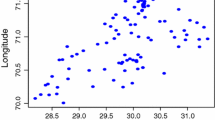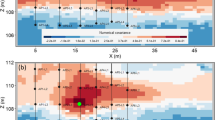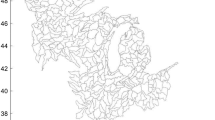Abstract
A regression model is used to study spatiotemporal distributions of solute content ion concentration data (calcium, chloride and nitrate), which provide important water contamination indicators. The model consists of three random and one deterministic components. The random space/time component is assumed to be homogeneous/stationary and to have a separable covariance. The purely spatial and the purely temporal random components are assumed to have homogenous and stationary increments, respectively. The deterministic component represents the space/time mean function. Inferences of the random components involve maximum likelihood and semi-parametric methods under some restrictions on the data configuration. Computational advantages and modelling limitations of the assumptions underlying the regression model are discussed. The regression model leads to simplifications in the space/time kriging and cokriging systems used to obtain space/time estimates at unobservable locations/instants. The application of the regression model in the study of the solute content ions was done at a global scale that covers the entire region of interest. The variability analysis focuses on the calculation of the spatial direct and cross-variograms and the evaluation of correlations between the three solute content ions. The space/time kriging system is developed in terms of the space direct and cross-variograms, and allows the separate estimation of the regression model components. Maps of these components are then obtained for each one of the three ions. Using the estimates of the purely spatial component, spatial dependencies between the ions are studied. Physical causes and consequences of the space/time variability are discussed, and comparisons are made with previous analyses of the solute content dataset.
Similar content being viewed by others
References
Christakos, G. 1991: A theory of spatiotemporal random fields and its application to space-time data processing. IEEE Trans. Systems, Man, and Cybernetics 21(4), 861–875
Christakos, G. 1992: Random Fields Models in Earth Sciences. Academic Press, New York
Christakos, G.; Bogaert, P. 1996: Spatiotemporal analysis of springwater ion processes derived from measurements at the Dyle basin in Belgium. IEEE Trans. Geosciences and Remote Sensing 34(3), 1–17
Christakos, G.; Raghu, V.R. 1996: Dynamic stochastic estimation of physical variables. Mathematical Geology 28(3), 341–365
Cressie N. 1991: Statistics for Spatial Data. Wiley, New York
Goovaerts, P.; Sonnet, Ph. 1993: Study of spatial and temporal variations of hydrogeochemical variables using factorial kriging analysis. Geostatistics 2, A. Soares (ed.), Kluwer Academic Publishers, 745–756
Goovaerts, P.; Sonnet, Ph.; Navarre, A. 1993: Factorial kriging analysis of springwater contents in the Dyle river basin, Belgium. Water Resour. Res. 29(7), 2115–2125
Handcock, M.S.; Wallis, J.R. 1994: An approach to statistical spatial-temporal modeling of meteorological fields. J. Am. Stat. Ass. 89(426), 368–378
Haas, T.C. 1995: Prediction of a first and second-order nonstationary spatio-temporal process. J. Am. Stat. Ass, to appear, preprint
Journel, A.G.; Huijbregts, C.J. 1978: Mining Geostatistics. Academic Press, London
Kitanidis, P.K. 1983: Statistical estimation of polynomial generalized covariance functions and hydrologic applications. Water Resour. Res. 19(4), 909–921
Marechal, A. 1984: Kriging seismic data in presence of faults. Geostatistics for natural resources characterization, G. Verly et al (eds.). Reidel, Dordercht, Holland, 271–294
Navarre, A.; Lecomte, P.; Martin, H. 1976: Analyse des tendances de donnees hydrogeochimiques du bassin de la Dyle en amont d'Archennes. Ann. Soc. Geol. Belg. 99, 299–313
Rouhani, S.; Hall, T.J. 1989: Space/time kriging of groundwater data. Geostatistics 2, M. Armstrong (ed), Avignon, 639–650
Rouhani, S., and Myers, D.E. 1990: Problems in space/time kriging of geohydrological data. Mathematical Geology 22(5), 611–623
Searle, S.R. 1971: Linear Models. Wiley, New York, NY.
Searle, S.R., Casella, G. and Ch.E. McCulloch 1992: Variance Components. Wiley, New York, NY
Seguret, S. 1989: Filtering periodic noise by using trigonometric kriging. Geostatistics 1, M. Armstrong (ed), Avignon, 481–491
Seguret, S. 1993: Analyse krigeante spatio-temporelle appliquee a des donnees aeromagnetiques. Cahiers de Geostatistique, Fasc. 3, Ecole National Superier des Mines de Paris, Fontainebleau, France, 115–138
Simard, Y.; Marcotte, D. 1992: Assessing similarities and differences among maps: A study of temporal changes in distribution of Northern Shrimp (Pandalus borealis) in the Gulf of St. Lawrence. Geostatistics 2, A. Soares (ed.), Troia, 865–874
Wackemagel, H. 1988: Geostatistical techniques for interpreting multivariate spatial information. Quantitative Analysis of Mineral and Energy Resources, C.F. Chung, A.G. Fabbri, and R. Sinding-Larsen (eds.). Reidel, Dordrecht, 393–404
Author information
Authors and Affiliations
Rights and permissions
About this article
Cite this article
Bogaert, P., Christakos, G. Stochastic analysis of spatiotemporal solute content measurements using a regression model. Stochastic Hydrol Hydraul 11, 267–295 (1997). https://doi.org/10.1007/BF02427919
Issue Date:
DOI: https://doi.org/10.1007/BF02427919




